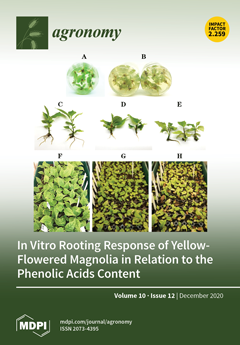It is important to strengthen the studies on the response of soil respiration components to tillage practices and natural precipitation in cropland. Therefore, soil heterotrophic respiration (R
H) and autotrophic (R
A) respiration were monitored by a root exclusion method in the North China Plain (NCP). The tillage practices included no-tillage (NT) and conventional tillage (CT), and the study periods were the summer maize growth stages in 2018 and 2019. R
H, R
A, soil water content and temperature were measured continuously for 113 days by an automatic sampling and analysis system. The soil R
H values on bright days and rain-affected days were higher under NT in 2018 (14.22 and 15.06 g CO
2 m
−2 d
−1, respectively) than in 2019 (8.25 and 13.30 g CO
2 m
−2 d
−1, respectively). However, the R
A values on bright days and rain-affected days were lower under NT in 2018 (4.74 and 4.97 g CO
2 m
−2 d
−1, respectively) than in 2019 (5.67 and 6.93 g CO
2 m
−2 d
−1, respectively). Moreover, NT decreased R
H but increased R
A compared to CT in 2019. Compared to bright days, the largest increase in both R
H and R
A after rain pulses was under CT in 2019 (6.75 and 1.80 g CO
2 m
−2 d
−1, respectively). Soil water content and soil temperature were higher in 2018 than in 2019. Moreover, NT increased soil water content and decreased soil temperature on bright days compared to CT in 2019. Furthermore, soil temperature accounted for more variations in R
H on bright days and rain-affected days, but soil water content had a greater influence on R
A on bright days. However, after precipitation, higher soil water content decreased R
A under NT in 2018, while soil water content was positively related to R
A under CT in 2019. This study determined the differential response of R
H and R
A to tillage practices and natural precipitation pulses, and we confirmed that excessively dry soil increases soil carbon loss after rain events in the NCP.
Full article





